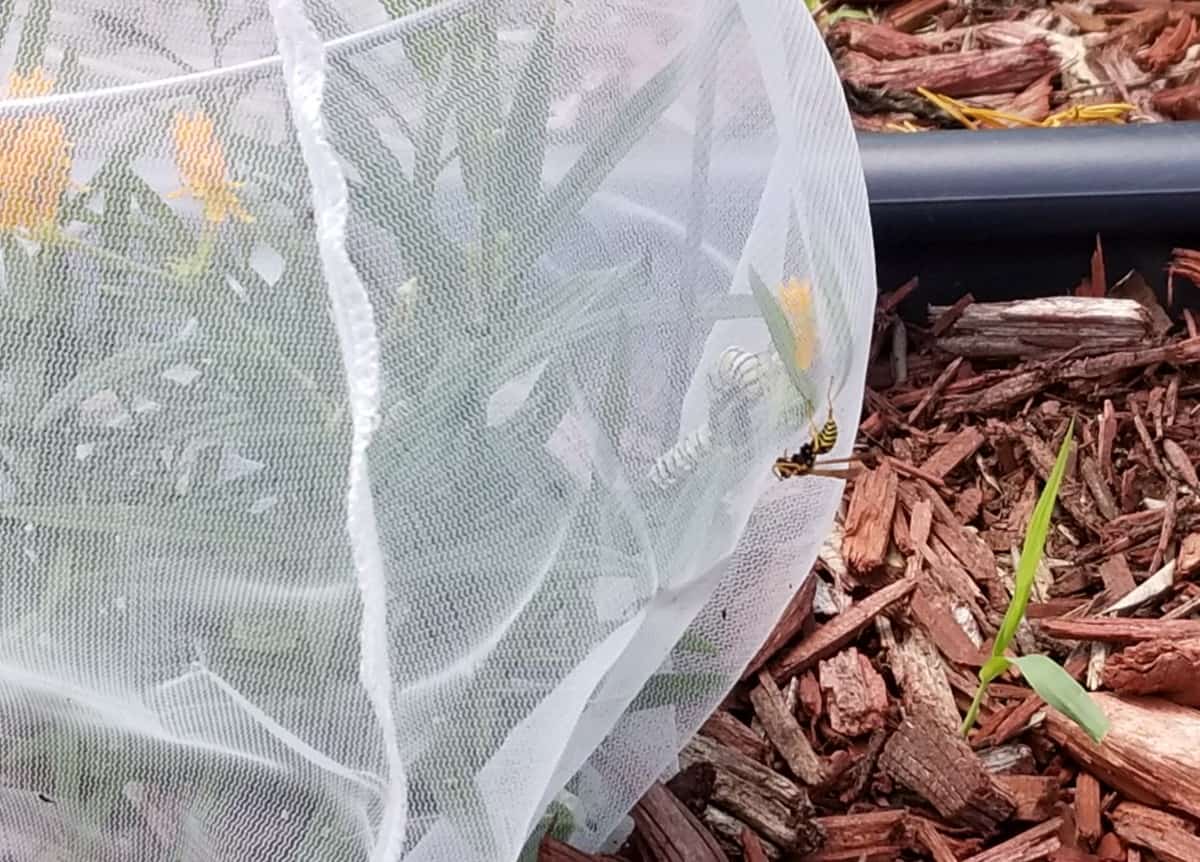Throughout our first year of raising Monarchs in the garden, we had five Monarchs that successfully made it from egg to caterpillar to butterfly. While this number may not seem high, our garden was only about a year old and our milkweed plants were still pretty small. We started growing Butterfly Weed (Asclepias tuberosa) from seed a year prior and they say it takes 3 years for milkweed started from seed to really take off. So we were pretty happy having some Monarch caterpillars after only 1 year. I had read several articles about raising Monarchs in your own garden, including an article on Monarch predators, so I made some cages to put over the plants to help protect the caterpillars.
After being successful at helping 5 Monarchs make it to adulthood by protecting them with simple cages, I thought we could continue to do the same thing the following year and hopefully have even more Monarch butterflies emerge from our garden. My goal seemed simple enough; if I successfully raised five Monarchs the first year, why not shoot for ten the following year? When that 2nd spring came along, our milkweed plants were much bigger, and I was excited by how many eggs I was seeing on the milkweed. At one point I think I had counted thirteen eggs. I thought that I would definitely be able to hit my goal of 10 Monarchs! My excitement quickly started to fade as I started to lose track of some of the eggs. There were some caterpillars did hatch from the eggs that I didn’t lose, but then I started losing track of the caterpillars, too. What the _ _ _ _? I know I am getting older, but I am not losing my mind that bad, am I? Where did all of the eggs and caterpillars go?
The closer I looked at the milkweed plants, the more I realized what the problem was: predators! There were other bugs eating the eggs and helpless little caterpillars! If you’re asking yourself why I didn’t use the cages to protect them, there were two reasons. The milkweed had really taken off this year and they would no longer fit in the cages; and I was trying to get as many caterpillars on the milkweed plants as I thought they would support before I covered them with cages. Continue reading to find out what predators I have had to deal with and what I did to reduce them to protect my Monarchs. I live in the northern Midwest of the US so the predators may or may not be the same as where you live.
Ants
One of the first pests I noticed were ants. The milkweed plants were covered with them, although I didn’t actually see any ants carrying or eating the Monarch eggs or caterpillars. But just based on the sheer number of ants climbing up and down the plants and checking every single leaf, I knew that there was a good chance that they were responsible for the missing Monarch eggs.
As I was researching how to get rid of ants from milkweed plants, somebody had recommended spreading coffee grounds around the plant. Apparently ants use scents to find their way around and coffee grounds messes with their sense of smell. I tried spreading coffee grounds around the bases of all the milkweed plants, but it didn’t seem to work.
Since the coffee grounds didn’t seem to stop the ants from invading the milkweed plants, I resorted to ant bait traps. We’ve had good luck with the Terro Liquid Ant Baits inside the house so I decided to try their outdoor Liquid Ant Bait Stakes. I placed them around the bases of the milkweed plants, and at first it didn’t look like they were working. It took a couple of days, but I gradually started seeing fewer and fewer ants on the plants.
Spiders
Around the same time I saw all of the ants on the milkweed, I also noticed a spider hanging around on the milkweed. I don’t know for sure if the spider was eating the Monarch eggs or not, but I didn’t want to take a chance. I ended up just moving him to another garden on the side of our house and have not seen it come back.
Wasps

This was probably the most maddening predator I’ve had to deal with so far. With the ants and spiders, they were on plants that weren’t protected with a cage. We had a pair of large Monarch caterpillars (probably in their 4th instar) on a milkweed plant that was covered with a cage. I checked on the caterpillars in the morning like I usually do and they were doing just fine, happily munching away on the milkweed. I came home from work late afternoon and found a wasp in the cage and the caterpillars were gone! The wasp was frantically trying to get out of the cage, but as he paused for a minute, I tried to get a good look at him and it looked like he still had part of a caterpillar in his mouth. Are you kidding me?! I was so disgusted that I killed him. I waited until he was at the top of the cage and I squeezed him between 2 pieces of wood mulch. I half jokingly refer to the caterpillars (and butterflies) as my kids. In a way they kind of are. And if someone harms or kills your kids, you want to do the same to them.
As we were trying to figure out how a wasp was able to get into the cage, we noticed there was a small gap between the bottom of the cage and the ground on one side of the cage. We figured that was how he got in. So we made sure that there weren’t any gaps around the other cages and built up some mulch around the bottom edges. Problem solved, right? Wrong!! Another wasp happened to get into another cage that we thought was pretty secured around the bottom. This cage also had 2 large Monarch caterpillars in it. Fortunately I was able to kill it before it killed both caterpillars, but it did manage to kill one of them before I got there. A day or 2 later, the caterpillar that survived, proceeded to hang in the “J” and successfully made it into its chrysalis. So that should give you an idea of what size caterpillars wasps are capable of killing and eating. This was a full sized, 5th instar Monarch caterpillar.
We are still not entirely sure how the wasp was able to get into the cage. Maybe there was one little section that had just enough of a space to squeeze through. Or maybe he burrowed underground? How he got into the cage became less important than how we were were going to get rid of the wasps from the garden. After the 1st incident where the wasp killed the 2 caterpillars, I tried to make one of those DIY wasp traps using a plastic pop bottle. (Note that I am from the Midwest United States and we say “pop”. You may call it soda or Coke.) One of the tricks to having a successful wasp trap is that you need to use the right bait. In the spring and early summer, wasps prefer protein. in late summer and early fall, they prefer sweets. We were in the middle of July so I wasn’t sure which bait to use. I tried making a sweet bait with some pineapple juice and pineapple chunks in it, but I did not catch a single wasp. Shortly after I put that DIY trap in the garden is when a wasp got into the 2nd cage and killed 1 of the 2 caterpillars in there before I killed the wasp.
It was at that point that I really went to war with the wasps. I bought some of these Yellow Jacket & Wasp Traps from our local hardware store. I used a combination of pineapple juice and lunch meat, figuring that I would lure them in if they were searching for protein or if they wre looking for sweets. I placed a couple of the traps on the ground among the milkweed plants. I managed to catch a single wasp and quite a few flies. I didn’t see any wasps hanging around (or in) the cages since I put the traps out. Maybe it was a small colony of wasps and I managed to kill or trap all 3 members, but I doubt it. I will always be on the lookout watching over my “kids”.
I did read something interesting when I was trying to figure out how to get rid of the wasps. Wasps tend to travel from their nest to their destination and back to the nest in a straight line. So if you are looking for their nest, watch the direction their flying and you should eventually have an idea of where their nest is. If you can find the nest, you can take action on the entire nest at once. In my case I was unable to locate the nest because the wasps were trapped either in the cages over the milkweed plants, or in the wasp trap so I couldn’t tell where they were coming from or going back to. One word of caution. If you are able to locate the nest, and plan on spraying it with wasp killer or taking some other action to destroy it, wait until dusk or dawn. Wasps are less active during these times.
Conclusion and Other Thoughts
So far, ants, spiders, and wasps are the only predators that I have had to deal with. If I come across others, I will update this article. When I was researching predators and how to handle them, one of the articles I read mentioned having a healthy ecosystem in your garden where both Monarchs and its predators can co-exist. While I would tend to agree with this, my mission is to do what I can to increase the Monarch population. And when all of the eggs and caterpillars started to go missing, I knew I had to step in and do something.
